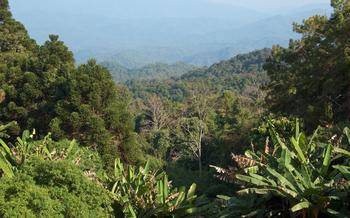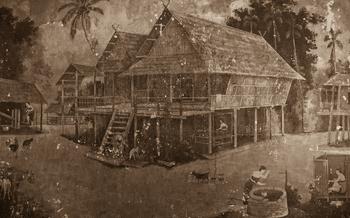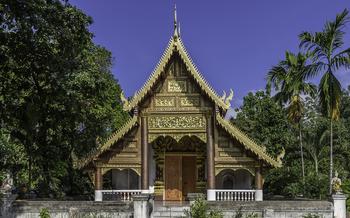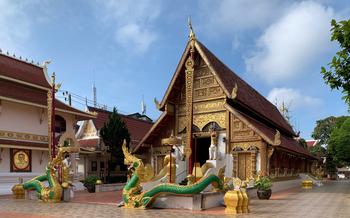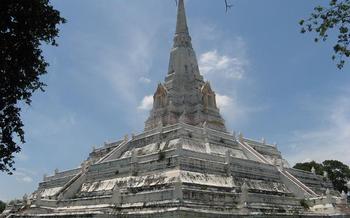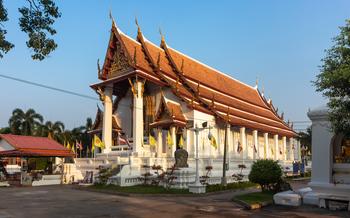
Wat Phra Bat Ming Mueang Worawiharn
- The Architecture of Wat Phra Bat Ming Mueang Worawiharn
- The Symbolism of the Different Elements of the Temple
- The Buddha Footprint
- The Temple Grounds
- The Monks of Wat Phra Bat Ming Mueang Worawiharn
- The Festivals and Ceremonies at Wat Phra Bat Ming Mueang Worawiharn
- The Local Community
- Getting to Wat Phra Bat Ming Mueang Worawiharn
- Things to Do at Wat Phra Bat Ming Mueang Worawiharn
- Where to Stay Near Wat Phra Bat Ming Mueang Worawiharn
- Where to Eat Near Wat Phra Bat Ming Mueang Worawiharn
- Insider Tip: A Unique Experience
The Architecture of Wat Phra Bat Ming Mueang Worawiharn
The architecture of Wat Phra Bat Ming Mueang Worawiharn is a unique blend of Thai and Burmese styles. The temple was built using traditional materials such as teak wood, brick, and stucco. The main features of the temple include a large Buddha footprint, a main ordination hall, a stupa, and a number of smaller buildings.
The main ordination hall is the largest building in the temple complex and is used for religious ceremonies and meditation. The hall is supported by massive teak columns and features a beautifully carved wooden ceiling. The stupa is located behind the main ordination hall and is topped with a golden spire. It is said to contain relics of the Buddha.
The Buddha footprint is the most sacred object in the temple and is located in a small shrine at the back of the main ordination hall. The footprint is carved into a large piece of black marble and is said to be the largest Buddha footprint in the world.
The temple is surrounded by a number of smaller buildings, including a library, a school, and a residence for the monks. The temple grounds are also home to a number of beautiful gardens and ponds.
The Symbolism of the Different Elements of the Temple
The different elements of Wat Phra Bat Ming Mueang Worawiharn are all highly symbolic. The Buddha footprint, for example, represents the Buddha's presence in the world and his teachings of peace and compassion. The main ordination hall represents the Buddha's teachings, and the stupa represents the Buddha's enlightenment.
The gardens and ponds in the temple grounds represent the natural world and the Buddha's teachings of harmony with nature. The temple is a place of peace and tranquility, and it is a popular destination for pilgrims and tourists alike.
The Buddha Footprint
The highlight of Wat Phra Bat Ming Mueang Worawiharn is undoubtedly the massive Buddha footprint enshrined within the temple's main hall. Measuring an astonishing 18 meters in length, it is considered the largest Buddha footprint in the world. The footprint is believed to be an imprint of Buddha's foot that miraculously appeared on the mountaintop centuries ago.
The materials used to create the footprint are unknown, and many legends surround its origins. Some believe that it was created from a mysterious rock that fell from the sky, while others claim that it was carved from a single piece of jade. Regardless of its origins, the Buddha footprint is a sacred object of immense reverence and a potent symbol of Buddha's presence in the region.
The footprint is enshrined in a beautiful golden chedi that sits at the center of the temple's main hall. Visitors can enter the chedi and see the footprint up close, marveling at its intricate details and sheer size. The footprint is covered with a layer of gold leaf, further enhancing its grandeur and reflecting the deep devotion of the local people.
The religious significance of the Buddha footprint is profound. It is seen as a tangible connection to Buddha himself and a reminder of his teachings and compassion. Many devotees come to the temple to pay homage to the footprint, seeking blessings and guidance. The footprint is also believed to possess miraculous powers, and people often come to pray for good fortune, health, and prosperity.
The Temple Grounds
The temple grounds of Wat Phra Bat Ming Mueang Worawiharn are extensive and well-maintained. The layout is symmetrical, with the main buildings and structures arranged around a central courtyard. The grounds are surrounded by a wall, which helps to create a sense of peace and tranquility.
The main buildings on the temple grounds include the ubosot, which is the main ordination hall, the viharn, which is the assembly hall, and the chedi, which is the reliquary stupa. The ubosot is a large, rectangular building with a tiled roof and elaborate carvings on the exterior. The viharn is a smaller building, but it is also very ornate. The chedi is a tall, bell-shaped structure that is covered in gold leaf.
In addition to the main buildings, the temple grounds also include a number of other structures, such as a library, a school, and a museum. There is also a large garden with a variety of flowers and trees. The garden is a popular spot for visitors to relax and enjoy the scenery.
The atmosphere and ambiance of the temple grounds are peaceful and serene. The grounds are well-maintained, and the buildings are all in good condition. The gardens are a beautiful and tranquil spot to relax and enjoy the scenery. The temple grounds are a popular spot for visitors to come and pay their respects to the Buddha.
The Monks of Wat Phra Bat Ming Mueang Worawiharn
The monks of Wat Phra Bat Ming Mueang Worawiharn are a dedicated and devout group of individuals who have chosen to devote their lives to the study and practice of Buddhism. They live a simple life, free from material possessions and worldly distractions, and their days are filled with prayer, meditation, and the study of Buddhist scriptures.
The monks play an important role in the local community, providing spiritual guidance and support to the villagers. They are also responsible for the upkeep of the temple and the organization of religious festivals and ceremonies. The monks are highly respected by the local people, who look to them for wisdom and guidance.
Visitors to the temple are often impressed by the monks' kindness and compassion. The monks are always happy to welcome visitors and answer their questions about Buddhism and the temple. They are also happy to share their knowledge of the local area and culture.
If you are lucky enough to visit Wat Phra Bat Ming Mueang Worawiharn, be sure to take some time to talk to the monks. They are a wealth of knowledge and wisdom, and they are always happy to share their insights with visitors.
The Festivals and Ceremonies at Wat Phra Bat Ming Mueang Worawiharn
The temple is the site of several festivals and ceremonies throughout the year. These events are an important part of the local culture and provide a glimpse into the beliefs and traditions of the people of Phayao.
One of the most important festivals is the Buddha Footprint Festival, which is held in March or April. This festival celebrates the discovery of the Buddha's footprint on the mountaintop. The festival features a procession of monks and villagers carrying a replica of the footprint from the temple to the mountaintop. There is also a fair with food, games, and music.
Another important festival is the Songkran Festival, which is held in April. This festival celebrates the Thai New Year. The festival features water fights, parades, and merit-making ceremonies.
In addition to these festivals, there are several other ceremonies that are held at the temple throughout the year. These ceremonies include ordination ceremonies, merit-making ceremonies, and funerals. These ceremonies are an important part of the life of the monks and the local community.
The Local Community
The village of Ban Wat Phra Bat Ming Mueang Worawiharn is home to a community of friendly and welcoming people. The villagers are proud of their temple and are happy to share its history and culture with visitors. They are also grateful for the economic benefits that tourism brings to their community.
The temple plays an important role in the life of the local community. It is a place where people can come to pray, to learn about Buddhism, and to celebrate festivals and ceremonies. The monks at the temple also provide social services to the community, such as education and healthcare.
The relationship between the monks and the local people is very close. The monks are respected and revered by the villagers, who look to them for guidance and support. The monks, in turn, are committed to serving the community and to helping to improve the lives of the villagers.
Tourism has had a positive impact on the local community. It has created jobs and boosted the local economy. The villagers have also benefited from the cultural exchange that has taken place with visitors from all over the world.
Overall, the local community is very supportive of the temple and its mission. The temple is a source of pride for the villagers and is an important part of their lives.
Getting to Wat Phra Bat Ming Mueang Worawiharn
Wat Phra Bat Ming Mueang Worawiharn is located in a remote area of Phayao Province, about 100 kilometers from the city of Phayao. The temple can be reached by car, motorcycle, or bus.
The most convenient way to get to the temple is by car. The drive from Phayao City takes about two hours. The temple is well-signposted, and the roads are in good condition.
If you are traveling by motorcycle, be sure to wear a helmet and drive carefully. The roads in the area are narrow and winding.
There are also several buses that run from Phayao City to the temple. The journey takes about three hours. The buses are not always reliable, so it is essential to check the schedule before you go.
Once you arrive at the temple, you will need to climb a flight of steps to reach the main entrance. The steps are steep, so be sure to wear comfortable shoes.
If you are short on time or have difficulty walking, you can hire a motorcycle taxi to take you to the top of the hill.
Things to Do at Wat Phra Bat Ming Mueang Worawiharn
There are many things to do at Wat Phra Bat Ming Mueang Worawiharn, including:
-
Visit the Buddha Footprint: The main attraction of the temple is the Buddha footprint, which is the largest in the world. Visitors can walk up to the footprint and examine it closely.
-
Explore the Temple Grounds: The temple grounds are extensive and include several other buildings and structures, such as a chedi, a viharn, and a sala. Visitors can wander around the grounds and admire the architecture or relax in the gardens.
-
Attend a Festival or Ceremony: Several festivals and ceremonies are held at the temple throughout the year. Visitors can participate in these events to learn more about Thai culture and Buddhism.
-
Meditate or Pray: The temple is a sacred place and is a popular destination for meditation and prayer. Visitors can find a quiet spot in the temple grounds to meditate or pray.
-
Take a Guided Tour: Guided tours of the temple are available for visitors who want to learn more about the history and significance of the site.
-
Enjoy the Views: The temple is located on a hilltop and offers stunning views of the surrounding countryside. Visitors can enjoy the views from the temple grounds or from the top of the chedi.
Where to Stay Near Wat Phra Bat Ming Mueang Worawiharn
There are a range of accommodation options to suit all budgets near Wat Phra Bat Ming Mueang Worawiharn. The most convenient option is to stay in one of the guesthouses or hotels in the village of Ban Doi Luang, which is located just a short walk from the temple. These guesthouses typically offer basic rooms with shared bathrooms, but they are clean and comfortable, and they represent excellent value for money.
For those looking for a more luxurious experience, there are a number of resorts located in the surrounding area. These resorts offer a variety of amenities, such as swimming pools, restaurants, and spas. They are typically more expensive than the guesthouses in Ban Doi Luang, but they offer a higher level of comfort and convenience.
No matter what your budget or preferences, you are sure to find a suitable place to stay near Wat Phra Bat Ming Mueang Worawiharn. The variety of accommodation options available means that everyone can find a place to stay that meets their needs and budget.
Where to Eat Near Wat Phra Bat Ming Mueang Worawiharn
There are a number of restaurants located near Wat Phra Bat Ming Mueang Worawiharn, offering a variety of cuisines to suit all tastes and budgets. For a truly authentic Thai experience, try one of the many local restaurants in the village, where you can sample delicious dishes such as khao soi, a northern Thai curry noodle soup, or sai ua, a grilled sausage made with pork and herbs. If you're looking for something a bit more familiar, there are also a number of international restaurants in the area, serving everything from pizza and pasta to burgers and fries.
No matter what your budget or taste, you're sure to find something to your liking near Wat Phra Bat Ming Mueang Worawiharn. Here are a few of the most popular restaurants in the area:
- The View Restaurant offers stunning views of the temple and the surrounding mountains, as well as a delicious menu of Thai and international dishes.
- The Riverside Restaurant is located on the banks of the Ping River and offers a relaxed atmosphere and a variety of Thai dishes.
- The Night Market is a great place to find a variety of street food stalls, selling everything from grilled meats to noodles to sweets.
- The 7-Eleven is a convenient option for those who are looking for a quick and easy meal.
Insider Tip: Be sure to try the khao soi at one of the local restaurants. This northern Thai curry noodle soup is a must-try for any visitor to the area.
Insider Tip: A Unique Experience
For a truly unforgettable experience, visitors to Wat Phra Bat Ming Mueang Worawiharn should consider staying overnight at the temple. This is an incredible opportunity to immerse oneself in the temple's serene atmosphere and witness the daily life of the monks. Visitors will be able to participate in the monks' morning chanting and meditation sessions, and enjoy the peace and tranquility of the temple grounds after the crowds have gone. Staying overnight at Wat Phra Bat Ming Mueang Worawiharn is a truly unique experience that will leave visitors with a lasting memory of their time in Thailand.

